
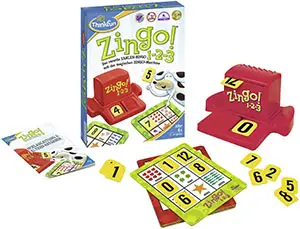
Components
- 72 ZINGO! Number Tiles
- 6 Two-Sided ZINGO! Cards
- 1 ZINGO! Zinger
- Instructions
Overview
Zingo! 1-2-3 tiles are printed with numbers 0 through 12. The cards have an easy and a hard side, allowing for two levels of game play. The spaces on the easy side feature groups of objects and are printed with the accompanying number words.
The spaces on the hard side feature different numbers of items with a plus sign in the middle to help build simple addition skills.
Zingo! 1-2-3 Skills:
Playing ZINGO! 1-2-3 will help children devel- op these important early math, social and learning skills:
- Counting
- Simple Addition
- Number Sense
- Comparing and Estimating
- Patterns and Matching
- Word Recognition
- Fine Motor Skills and Coordination
- Following Instructions
- Taking Turns
- Winning and Losing
Object of the Game
Be the first to cover all the spaces on your ZINGO! 1-2-3 card with matching number tiles!
Setup
-
Remove the top from the ZINGO! Zinger and scramble the 72 tiles.
-
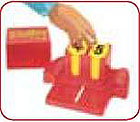
Load the tiles back in the Zinger in two equal stacks and replace the top.
-
All players should have a clear view of the ZINGO! Zinger before play begins.
-
Each player selects a ZINGO! 1-2-3 card. Cards are two-sided to allow for two levels of play. All players should have the same colored side facing up.
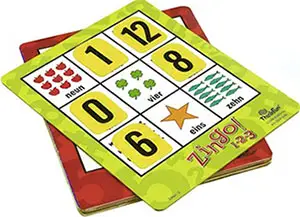
Green Side: Each square on this side contains images of various groups of objects with the corresponding number written out.
Red Side: Each square on this side contains two sets of images with a plus sign for addition. This side does not show the corresponding number, so players rely on addition skills to make a match.
Reloading Zingo! Tiles:
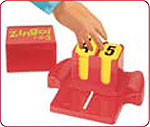
Remove cover to reload tiles when Zinger is less than half full.
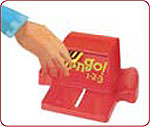
Reload tiles through cover slots when Zinger is more than half full.
Game Play
-
Decide whether one player will serve as Dealer and operate the ZINGO! Zinger, or whether players will pass the Zinger each turn, giving everyone a chance to operate the device during a game. We recommend choosing an adult or older child to be the first Dealer.
-
The Dealer slides the ZINGO! Zinger forward and back to reveal two tiles.

-
When a player sees a Number Tile that matches an image on his/her ZINGO! Card, the player calls out the number, takes the tile and covers the printed image on the card.

The Dealer slides any unclaimed tiles back into the Zinger through the slots at the top of the device.
-
If two or more players need the same tile, it goes to the player who calls for it first. In the case of a tie, the Dealer slides the tile back in the ZINGO! Zinger.
-
If a player calls for a tile he/she doesn't need, the tile goes to the next player to correctly call it.
-
The first player to cover all 9 spaces on the card shouts "ZINGO!" and wins!
-
The winner starts the next game as the Dealer.
Game Variations
Try out some exciting new play variations for an added Zing!
Mini-zingo! 1-2-3
The first player to match three images in a row-across, up, down or diagonally-is the winner!
Zany Zingo! 1-2-3
Select a pattern to match; the first player to match the pattern is the winner!
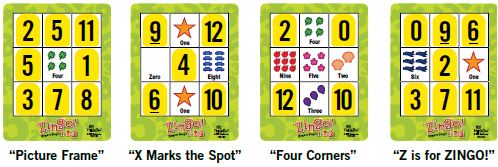
Multi-card Zingo! 1-2-3
Use two or more cards each round. Try playing with one green and one red card. The first player to fill one of his/her cards wins!
Parent's Guide
A zany Zinger and fast-paced matching make ZINGO! 1-2-3 a fun way to help your child develop early math, learning, and social skills. At around age 3, children begin practicing their number skills through counting and sorting activities.
They start to understand and use numerals to represent amounts, and they benefit greatly from functional opportunities to practice their counting and labeling skills.
For this reason, the green sides of the ZINGO! 1-2-3 cards feature images and number words. ZINGO! 1-2-3 draws upon a young child's growing interest in number play as well as his/her natural love of matching games to create a fun-filled, enriching play experience.
As children get older and gain experience practicing early math skills, they are able to understand more complex number concepts such as estimating, combining amounts and using mathematical symbols.
Once your child is ready, flip the ZINGO! 1-2-3 cards to the red side and share in the exciting new skill-building challenge of simple image addition!
While thinking skills develop naturally through growth and exploration, it's important that children are provided with frequent and varied opportunities to test their abilities in new ways. The gameplay is a great way to support the cognitive and social development that will serve a child throughout his/her life.
Continue Reading


